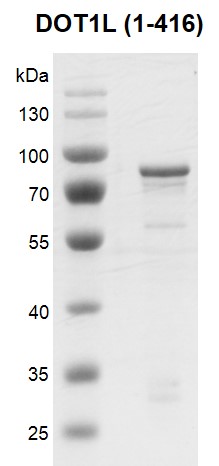Recombinant DOT1L (1-416) protein
Expressed In
E. coli
Protein Species
Human
Cat No : 31474,31874 31474
验证数据展示
产品信息
| Expressed In | E. coli |
| Protein Species | Human |
Contents
Recombinant DOT1L (1-416) protein is supplied in 25 mM Tris pH 8.0, 300 mM NaCl, 5% glycerol.
背景介绍
DOT1L (Disruptor of Telomeric silencing 1-like, also known as KMT4) is the mammalian homologue of the yeast Dot1 protein and the Drosophila Grappa protein. DOTL1 is the enzyme responsible for lysine 79 methylation of histone H3. DOT1L can promote an oncogenic pattern of gene expression through binding with several MLL fusion partners found in acute leukemia, thus leading to aberrant methylation of lysine 79 at MLL target genes. In contrast to most other histone lysine methyltransferases, DOT1L does not contain a SET domain. Biochemical studies suggest that recombinant DOT1L is active on recombinant nucleosomes.
Application Notes
Recombinant DOT1L (1-416), active protein is suitable for use in the study of enzyme kinetics, inhibitor screening, and selectivity profiling. HMT Assay Conditions: 2 ug recombinant nucleosomes were incubated with DOT1L in reaction buffer including 50 mM Tris-HCl, pH 8.6, 0.02% Triton X-100, 2 mM MgCl2, 1 mM TCEP, 50 uM SAM for 3 hours at room temperature. Western blot was used for activity detection. Western Blot was used to detect the generation of reaction products (Anti-H3K79me1, Cat. No. 39921, 1:000 dilution). DOT1L only was used as negative control.
Protein Details
Recombinant DOT1L (1-416) protein that includes amino acids 1-416 that contains the SET domain sequence of the human DOT1L protein (accession number NP_115871.1) was expressed in E. coli cells and contains an N-terminal GST-Tag with an observed molecular weight of 72 kDa.
Storage
Recombinant proteins in solution are temperature sensitive and must be stored at -80°C to prevent degradation. Avoid repeated freeze/thaw cycles and keep on ice when not in storage.
Guarantee
This product is guaranteed for 6 months from date of receipt.
This product is for research use only and is not for use in diagnostic procedures.


